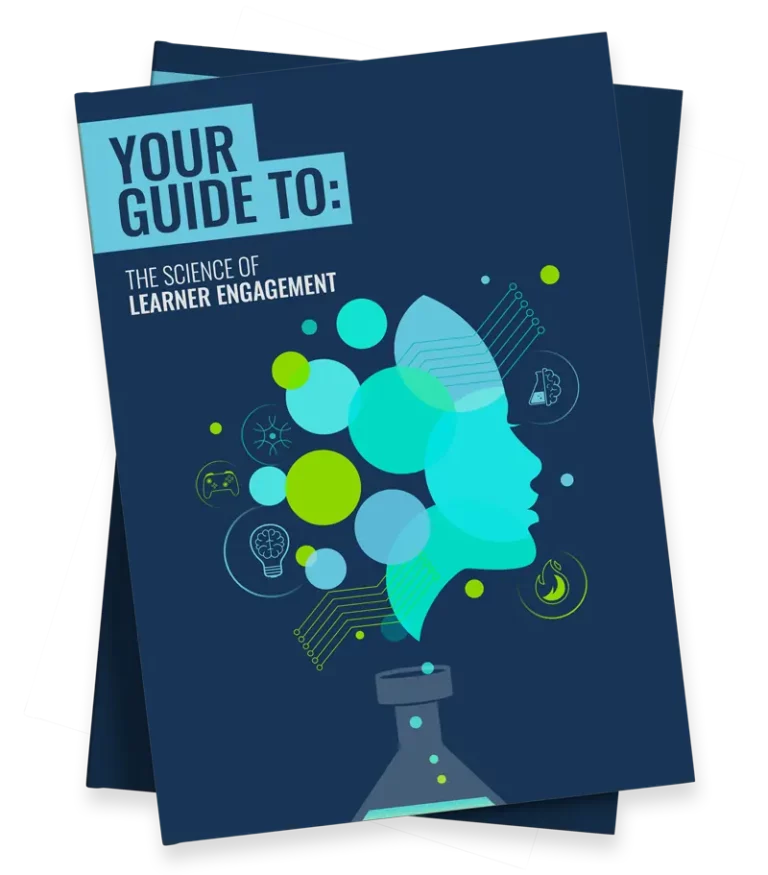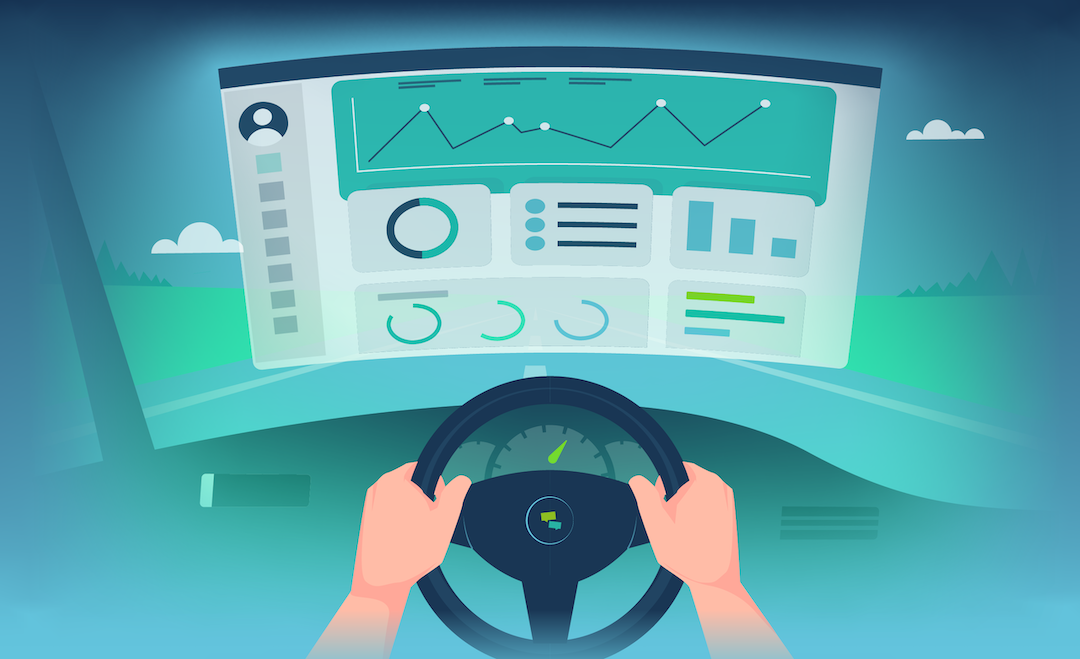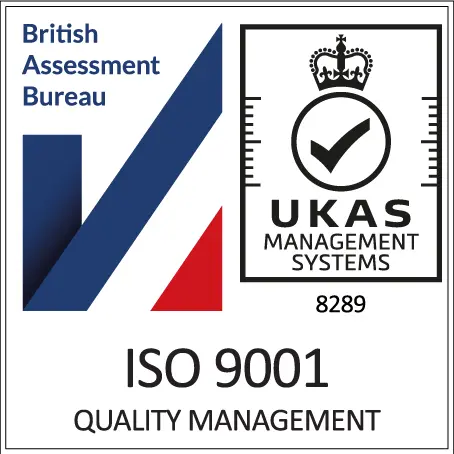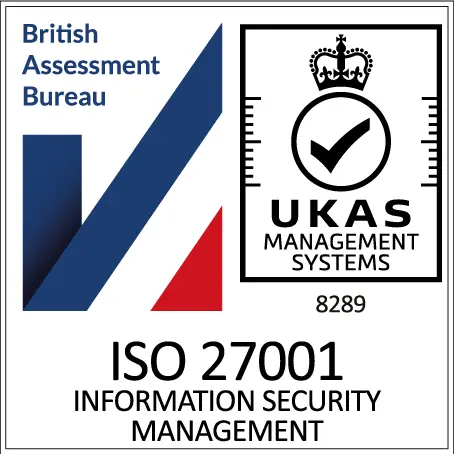
Throwing learners into an unsorted pile of educational content is like tossing someone into the ocean and yelling ‘Swim!’ While a few might instinctively find their way, most will likely feel overwhelmed, drift aimlessly, or simply struggle to reach the shore.
Enter learning pathways: your antidote to all the chaos. These structured programmes act as clear step-by-step guides, leading your learners confidently through each stage of their development journey.
This translates directly to reduced stress, built-in momentum, and significantly less time wasted for everyone involved.
In this article, we’ll explore the power of the pathway and share a boatload of best practice tips to help you design them effectively. But first, let’s examine two distinct learning pathways: curricula and levels.
Learning Pathway Types
Note: While we wrote this guide with Growth Engineering LMS users in mind, the strategies and tips inside are universal. No matter what type of structured learning experience you’re creating, you’ll walk away with brilliant suggestions and ready-to-use strategies you can apply immediately.
1. What is a Curriculum?
A curriculum (singular) or curricula (plural) is a structured learning pathway designed to guide learners through a sequence of content. These learning pathways are ideal for compliance training, certification programmes, or any scenario where systematic progress matters.
Content release options include:
- Open Access: All content is available immediately.
- Fixed Order: Individual content unlocks sequentially.
- Checkpoint-Based: New sections unlock sequentially.
Learners earn a certificate upon completing a curriculum. This is a tangible mark of their achievement. Need to keep knowledge fresh? Set your certificates to expire, prompting learners to revisit and recomplete the materials at a future date.
2. What is a Level?
Levels offer a highly motivating, gamified progression framework. With this pathway, learners unlock new stages by consuming required or optional content and earning experience points (XP). These learning pathways encourage deeper exploration and continuous engagement.
Adding to their versatility, levels also support a wider array of content types:
| Content Type | Curricula | Levels |
| eLearning | ✔ | ✔ |
| Videos | ✔ | ✔ |
| Events | ✔ | ✔ |
| Materials | ✔ | ✔ |
| Reviews | ✔ | ✔ |
| Reading | ✔ | ✔ |
| Assessments | ✔ | ✔ |
| Achievements | ✔ | |
| Curricula | ✔ |
Levels supercharge motivation by transforming progression into a visually rewarding journey fuelled by epic meaning. As a result, you can create themed learning pathways that are as professional as Beginner → Novice → Expert or as playful as Padawan → Jedi → Grand Master.
Curriculum vs Levels
At this stage, you may well be wondering: “When should I use curricula versus levels?” Well, the answer depends heavily on your programme’s objectives, desired learning experience, and the type of content being delivered.
But don’t worry, we’ve got your back! Here’s how you can decide:
Choose Curricula When You Need:
- Mandatory completion (compliance and certifications)
- Linear skill-building (step-by-step mastery)
- Documented proof of completion (certificates)
Choose Levels When You Want:
- Sustained engagement (gamified and long-term programmes)
- Flexible exploration (with a mix of required and optional content)
- Visible progression (badges, status tiers, epic meaning)
Still not sure? The table below highlights the key differences between curricula and levels at a glance, so you can confidently choose what’s right for your programme.
| Feature | Curricula | Levels |
| Structure | Linear or checkpoint-based | Flexible (required + optional content) |
| Completion Reward | Certificate (expirable) | Levelling up, Badges, XP |
| Content Types | eLearning, Videos, Assessments, etc. | All Curricula objects + Achievements |
| Primary Goal | Ensure mastery of a topic | Encourage exploration and engagement |
| Progression Trigger | Finishing content | Finishing content + XP targets |
| UI/UX Focus | Clear completion tracking | Gamification and epic meaning |
Pro Tip: Many successful learning programmes combine both pathway types. After all, you can marry structure with motivation by nesting curricula within levels.
Why Does Structure Matter?
We’ve all experienced that overwhelming moment: staring at a disorganised learning portal with 57 unrelated courses, wondering “Where do I even start?” It turns out our brains don’t just prefer structure, they require it for effective learning. Here’s why:
- Preventing Cognitive Overload: According to cognitive load theory, effective learning hinges on how we manage our brain’s limited resources. In fact, our working memory is only capable of holding 5-9 pieces of information at any given time. Thankfully, a structured curriculum acts like ‘mental guardrails’ breaking down topics and preventing overload.
- The Progress Principle: Harvard research shows that visible progress is a powerful motivator. When learners hit milestones or advance through levels, their brains release dopamine (the ‘feel-good’ chemical). This creates a virtuous cycle where success fuels further motivation, driving learners through the entire curriculum.
- Building Confidence: Similarly, as learners collect these small wins, they start to build their confidence. After all, they act as micro-validations that prove competency (a key component of Self-Determination Theory) and reduce anxiety. In turn, this makes each learner more likely to embrace fresh challenges in the future.
- Foundational Knowledge: Ever had learners stumble because they missed a vital step? Fortunately, sequential design and mandatory checkpoints prevent these knowledge gaps from forming. This ensures that your learners grasp fundamental concepts and achieve 100% coverage of mission-critical information.
- Scaffolding Information: Drawing on the principles of the Zone of Proximal Development, learning thrives when it’s appropriately challenging. In other words, it should be neither too easy, nor too difficult. A structured curriculum provides essential ‘scaffolding’, guiding learners step-by-step through complex topics.
Beyond boosting engagement, structured learning pathways also solve a critical operational challenge: effortless scaling. Instead of your L&D team juggling invites to countless individual lessons, you simply enroll learners onto one smart, comprehensive path. That’s it!
Even better, a lot of this can be automated by integrating your learning management system with your HR system. This seamless connection ensures that new hires are automatically added to your platform and instantly enrolled onto the learning pathways of your choice.
What the Research Says
The evidence is clear: intentional design doesn’t just organise content, it transforms your learning outcomes. There’s a wealth of research out there that shows that reducing cognitive load boosts learning efficiency. But it doesn’t stop there:
- John Hattie’s landmark research ranks scaffolding among the top 20 most impactful learning strategies (with an effect size of 0.82).
- This 2023 study demonstrates that structure and clarity are key drivers in learner motivation that can lead to higher examination scores.
- And this 2024 study shows that progress indicators have a strong influence on both learner engagement and learner experience.
Just remember, the sweet spot often lies in offering a smart blend of structured pathways and flexible exploration, giving learners the best of both worlds.
Suggested Learning Pathway Structures
Just like architects choose blueprints based on a building’s purpose, learning designers should strive to match curricula structure to clear goals. The good news is, you have a healthy selection of options available to you. Here are five dynamic structures to consider:
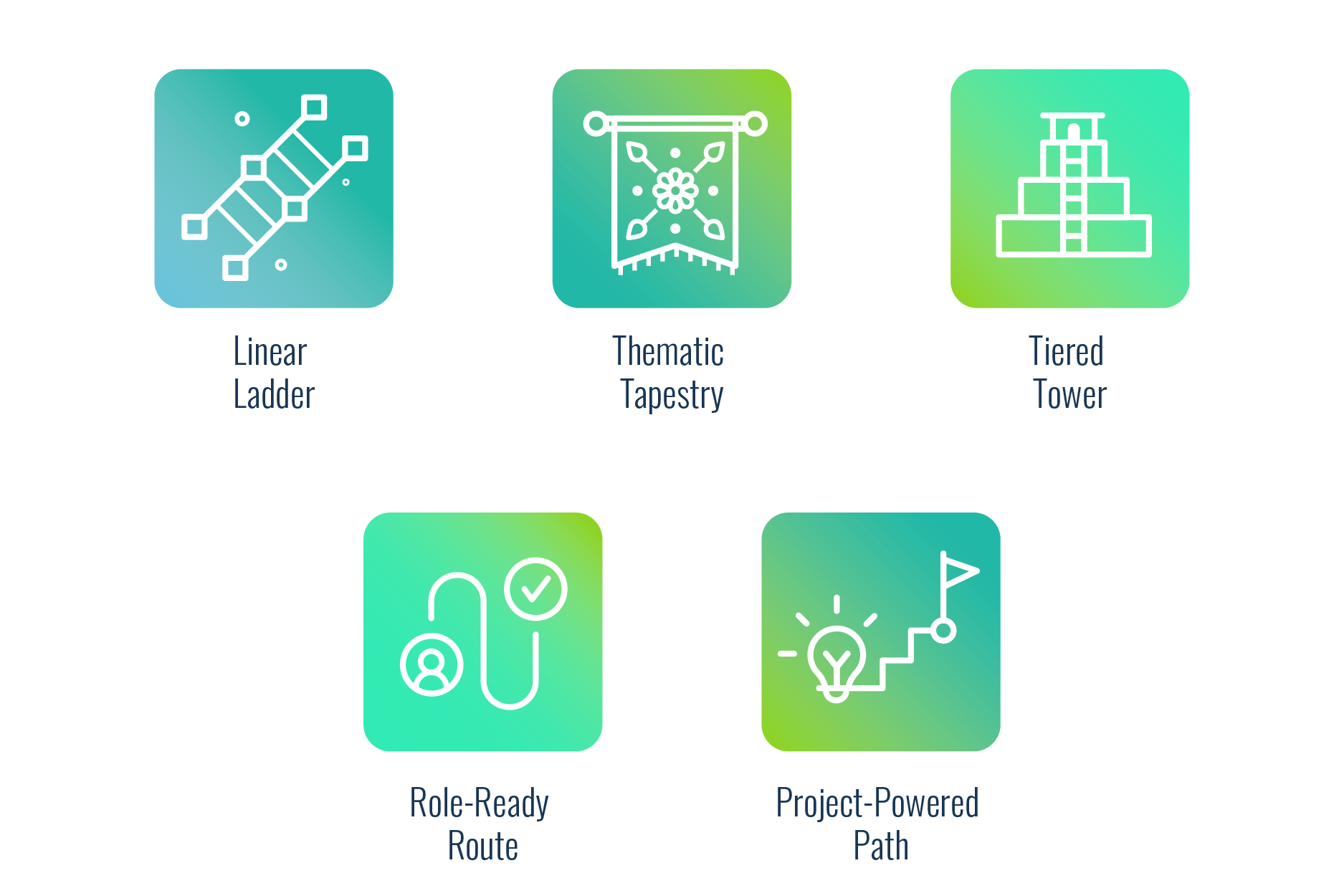
- The Linear Ladder: This structure guides your learners through content in a strict, step-by-step sequence. Each learning object should build directly on the last, ensuring foundational knowledge is in place before they move on. It’s perfect for mandatory training or technical skills where fundamentals are prerequisites.
- The Thematic Tapestry: This approach organises content into distinct, self-contained modules or themes, each focused around a specific topic. It shines when you want learners to truly focus and master one area at a time. For instance, you could create a ‘Leadership Development’ curriculum.
- The Tiered Tower: Here, learners should advance through stages of increasing difficulty or complexity, starting with the basics and culminating in advanced expertise. This is ideal for skill development programmes, certifications, or career progression paths that require a cumulative journey towards proficiency.
- The Role-Ready Route: This pathway is all about tailoring learning content directly to the specific job roles, departments, or career paths within your organisation. Your goal should be to ensure that individuals receive relevant and practical training that is immediately applicable to their day-to-day responsibilities.
- The Project-Powered Path: Finally, this dynamic structure focuses on solving real-world problems or completing practical projects. It’s an excellent choice for programmes where experiential learning and application are key. For instance, you could design a path around ‘How to Build a Marketing Plan’, or ‘Optimising Customer Service Response Times’.
Core Learning Pathway Design Principles
Designing the perfect curriculum isn’t just about content — it’s about strategy, engagement, and measurable outcomes. With this in mind, here are six foundational principles to help you build effective structured learning experiences.
- Start with a Clear Objective: As with any learning initiative, you should start by defining specific, measurable outcomes for your curriculum. For example, ‘By the end, learners will be able to troubleshoot X software error in under 5 minutes’. Just ensure your objective directly supports a core business goal and is presented in terms that resonate with your learners.
- Establish Assessment Methodology: Once your objectives are crystal clear, determine how you will measure if learners have met them. Consider which formative checks (quizzes, simulations, etc.) and summative evaluations (final assignments) you’ll use and when you’ll use them.
- Chunk Your Content: As we’ve seen, our brains have limited capacity. Review all your content tied to your learning objective and determine what’s essential and what can be omitted. Where possible, break down existing material into smaller, digestible chunks. For example, a 1-hour course is far more effective when delivered as four 15-minute scenarios.
- Vary Content Formats: Remember, variety is the spice of life. Mix eLearning, videos, infographics, and more to help maintain learner interest throughout your curriculum. You can even weave in a real-world event or a live virtual session to create a blended learning experience. Whatever you do, please don’t drown your learners in endless PDFs!
- Integrate Application: As Bloom’s Taxonomy shows, true mastery happens when learners use knowledge, not just consume it. With this in mind, don’t forget to include application opportunities such as scenario-based learning or real-world tasks (e.g. ‘Upload a screenshot of your completed project’) within your curriculum.
- Provide Feedback: Learning thrives on dialogue. Offer immediate and insightful feedback for assessments, both at an overall level and for individual questions. Crucially, remember to also solicit feedback from your learners, so you can establish what’s working well within your curricula and what could be improved.
As well as your learner feedback, you’ll want to keep an eye on both completion rates and time-to-completion. These important metrics will help you to understand how quickly people are mastering the material and if they’re hitting any unexpected bumps along the way.
However, the ultimate goal isn’t just finishing a course, it’s applying what they’ve learned in the real world. As such, let your practical assessment results be the shining stars among your reports, showing the true, tangible impact of your training.
For more guidance on training evaluation, head here.
Further Learning Pathway Tips

With these foundational design principles in place, you can craft a highly structured curriculum that sets learners up for success. To take things to the next level, however, consider implementing the following engagement-focused strategies:
- Magnetic Descriptions: First impressions drive engagement, so you’ll need to use your curriculum’s title, description, and image wisely. We recommend using benefit-driven titles, adding high-quality visuals that reflect the content, and including ‘You’ll learn how to…’ bullet points in your descriptions.
- Assessment Gateways: Strategically place assessments as ‘gateways’ throughout the learning journey, not just at the very end. These can be short quizzes or quick checks before each checkpoint, ensuring learners have grasped all the key concepts and are ready to advance with confidence.
- Smart Checkpoints: Likewise, integrate checkpoints thoughtfully to segment your content into manageable, logical groups. They should act as clear markers of learners’ progress through the curriculum. And don’t spread your checkpoints too far apart. Shorter, more frequent checks help to keep momentum high.
- Game Mechanics: Gamification helps to make learning an engaging experience. Ensure each item within your curriculum has an associated digital badge and experience points. Leaderboards and Knowledge Contests can also be used to fuel friendly competition and create a rewarding sense of achievement.
- Social Synergy: Let learning live on outside of your curricula by encouraging social learning activity. You can achieve this by including relevant Achievements (interaction badges) within your curriculum or asking your learners to upload and share evidence of their work. Get ready for a knowledge sharing utopia!
Final Words
Transforming your learning programmes into truly engaging journeys begins with thoughtful structure. This helps to reduce cognitive load and break progress down into rewarding milestones for your learners.
By applying the structures and principles we’ve explored you’ll turn chaos into clarity, and reluctant learners into engaged achievers. It also means less frustration and wasted time spent searching for elusive content.
So, don’t let your valuable training materials get lost in the shuffle. Instead, unleash your inner learning architect, and craft some truly unforgettable pathways. Your learners will definitely thank you for it!
Thanks for reading. If you’ve enjoyed this content, please connect with me here or find more articles here.
Learning pathways? Oh, they’re just the beginning! Want the full playbook on learner engagement? Grab ‘Your Guide to the Science of Learner Engagement’ now!

